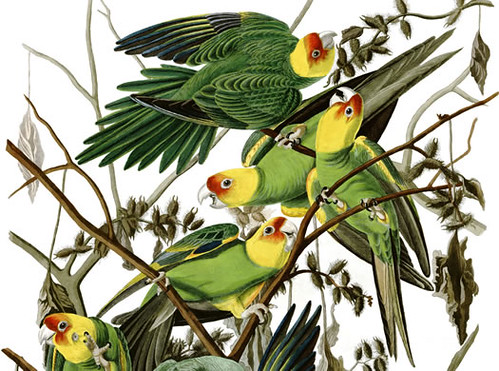 From an 1825 illustration by John James Audubon.As strange as it might sound, there were once parrots -- parakeets, specifically -- that were native to New York State. The range of the Carolina Parakeet stretched as far north as the Great Lakes, and there are historical reports of them in Albany.
From an 1825 illustration by John James Audubon.As strange as it might sound, there were once parrots -- parakeets, specifically -- that were native to New York State. The range of the Carolina Parakeet stretched as far north as the Great Lakes, and there are historical reports of them in Albany.
They were brightly colored. They were loud. And by the late 1800s, they were gone from here. After the early 1900s, they were extinct.
Jeremy Kirchman -- the State Museum's curator of birds -- has been studying the Carolina Parakeet in order to figure out where the birds fit on the parakeet family tree. The State Museum has four of the parakeets in its collection. Two of them are now on display in the lobby gallery.
"They're unusal because they were the farthest north parrot in North America. It's unknown whether they were here year round, or seasonally," Kirchman told us today. He says the birds have been extinct for so long that there wasn't a chance to for them to be studied.
But Kirchman says what scientists do know a bit about their behavior -- and how that probably contributed to their downfall.
"They were crop pests and they were gregarious, meaning they would form flocks. And if they descended on your apple orchard, you'd defend it with a shot gun." Kirchman says just as farmers hunted down and shot wolves that threatened their livestock, they also went after the parakeets for threatening their crops.
Also part of their undoing: hats.
One of the fashion crazes of the 1800s included people adorning hats with brightly colored feathers. And who had bright, beautiful feathers? Yep, you guessed it.
"You certainly could have made money by selling shot parakeets to people making hats."
Add in the fact that the parakeets' habitat was the forested area of river valleys -- just the sort of place humans were building cities -- and there were no laws to protect wild bird populations, and the Carolina Parakeet's days were numbered. By the late 1800s they were rarely seen outside of Florida, and were considered extinct by the 1920s.
Where the bird sits in the tree
 April issue of the journal of the American Ornithologists' UnionOne of Kirchman's research areas includes ancient bird DNA. So when he got to talking with a friend who was studying South American parakeets, he saw an opportunity to research where New York's (once) native parakeet fit into the bigger family tree. He was able to extract DNA from the State Museum's specimens and compare it against the DNA sequences of the other parakeets.
April issue of the journal of the American Ornithologists' UnionOne of Kirchman's research areas includes ancient bird DNA. So when he got to talking with a friend who was studying South American parakeets, he saw an opportunity to research where New York's (once) native parakeet fit into the bigger family tree. He was able to extract DNA from the State Museum's specimens and compare it against the DNA sequences of the other parakeets.
Kirchman says what he and researchers from New Mexico State University found is that the Carolina Parakeet sits on a long branch of the genetic tree. It's most closely related not to parakeets of from relatively nearby places such as Mexico and the Caribbean, but rather birds from Central and South America. Bayesian and maximum likelihood analyses place C. carolinensis on a long branch within a well-supported clade of parakeets that also includes Aratinga solstitialis, A. auricapillus and Nandayus nenday. These species of Aratinga (but not N. nenday) closely resemble C. carolinensis in the presence of yellow and orange head plumage and blue feathers in the wings. By using the DNA evidence, they were able to infer that the Carolina Parakeet probably colonized North American about 5 million years ago. Their research was the cover article in the April issue of the journal of the American Ornithologists' Union.
Five million years is a good run. It's just tough when it ends on a hat.
Things are different now
As recently as just a few decades ago, other bird species in New York were in serious danger. Kirchman says the state had almost lost all its peregrine falcons, ospreys, and bald eagles. But environmental laws have made a signficant difference. "Because of tighter regulation on shooting birds, and pesticides, a lot of those populations are doing better now," he says.
Jeremy Kirchman will be giving a talk about the Carolina Parakeet at the State Museum this Saturday at 1 pm. It's free.
And, as mentioned, two of the museums four Carolina Parakeet specimens are on display in the museum's lobby for the next few months. Kirchman says there are only a few hundred specimens of the birds remaining in museum collections.